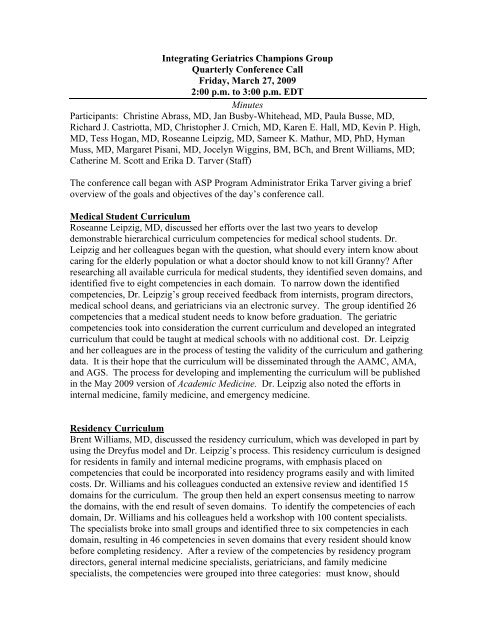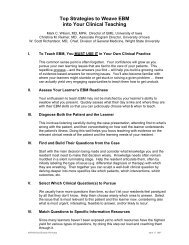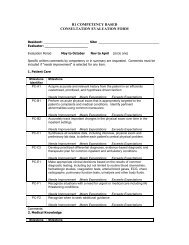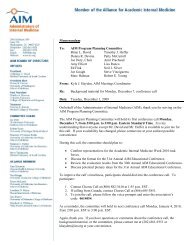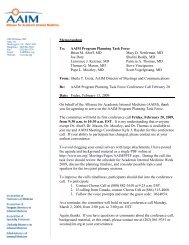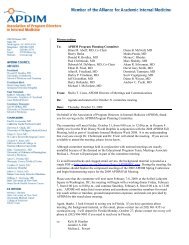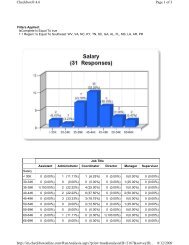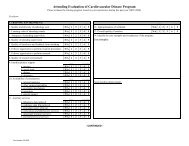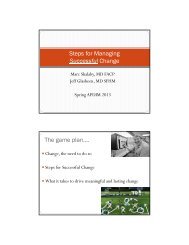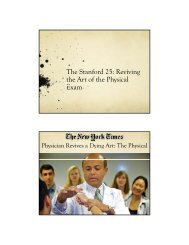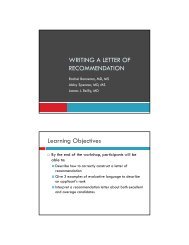March 27, 2009 Minutes
March 27, 2009 Minutes
March 27, 2009 Minutes
Create successful ePaper yourself
Turn your PDF publications into a flip-book with our unique Google optimized e-Paper software.
Integrating Geriatrics Champions Group<br />
Quarterly Conference Call<br />
Friday, <strong>March</strong> <strong>27</strong>, <strong>2009</strong><br />
2:00 p.m. to 3:00 p.m. EDT<br />
<strong>Minutes</strong><br />
Participants: Christine Abrass, MD, Jan Busby-Whitehead, MD, Paula Busse, MD,<br />
Richard J. Castriotta, MD, Christopher J. Crnich, MD, Karen E. Hall, MD, Kevin P. High,<br />
MD, Tess Hogan, MD, Roseanne Leipzig, MD, Sameer K. Mathur, MD, PhD, Hyman<br />
Muss, MD, Margaret Pisani, MD, Jocelyn Wiggins, BM, BCh, and Brent Williams, MD;<br />
Catherine M. Scott and Erika D. Tarver (Staff)<br />
The conference call began with ASP Program Administrator Erika Tarver giving a brief<br />
overview of the goals and objectives of the day’s conference call.<br />
Medical Student Curriculum<br />
Roseanne Leipzig, MD, discussed her efforts over the last two years to develop<br />
demonstrable hierarchical curriculum competencies for medical school students. Dr.<br />
Leipzig and her colleagues began with the question, what should every intern know about<br />
caring for the elderly population or what a doctor should know to not kill Granny? After<br />
researching all available curricula for medical students, they identified seven domains, and<br />
identified five to eight competencies in each domain. To narrow down the identified<br />
competencies, Dr. Leipzig’s group received feedback from internists, program directors,<br />
medical school deans, and geriatricians via an electronic survey. The group identified 26<br />
competencies that a medical student needs to know before graduation. The geriatric<br />
competencies took into consideration the current curriculum and developed an integrated<br />
curriculum that could be taught at medical schools with no additional cost. Dr. Leipzig<br />
and her colleagues are in the process of testing the validity of the curriculum and gathering<br />
data. It is their hope that the curriculum will be disseminated through the AAMC, AMA,<br />
and AGS. The process for developing and implementing the curriculum will be published<br />
in the May <strong>2009</strong> version of Academic Medicine. Dr. Leipzig also noted the efforts in<br />
internal medicine, family medicine, and emergency medicine.<br />
Residency Curriculum<br />
Brent Williams, MD, discussed the residency curriculum, which was developed in part by<br />
using the Dreyfus model and Dr. Leipzig’s process. This residency curriculum is designed<br />
for residents in family and internal medicine programs, with emphasis placed on<br />
competencies that could be incorporated into residency programs easily and with limited<br />
costs. Dr. Williams and his colleagues conducted an extensive review and identified 15<br />
domains for the curriculum. The group then held an expert consensus meeting to narrow<br />
the domains, with the end result of seven domains. To identify the competencies of each<br />
domain, Dr. Williams and his colleagues held a workshop with 100 content specialists.<br />
The specialists broke into small groups and identified three to six competencies in each<br />
domain, resulting in 46 competencies in seven domains that every resident should know<br />
before completing residency. After a review of the competencies by residency program<br />
directors, general internal medicine specialists, geriatricians, and family medicine<br />
specialists, the competencies were grouped into three categories: must know, should
know, and do not need to know. From this grouping, Dr. Williams and his colleagues were<br />
able to identify 26 competencies every resident should know at the completion of their<br />
residency.<br />
Lessons Learned<br />
Dr. Leipzig, Dr. Williams, and Teresita Hogan, MD, discussed the challenges they faced<br />
with developing the curricula for medical students, internal and family medicine residents,<br />
and emergency medicine residents. Listed below is a summary of the lessons learned:<br />
Don’t reinvent the wheel: Before taking on a major task like a curriculum, it is critical to<br />
conduct a review of existing material. An excellent clearinghouse for some geriatricfocused<br />
educational material is through POGOe.<br />
Integrated team: If developing a curriculum for fellows, it is important to move beyond<br />
the subspecialty to include various viewpoints. At a minimum, the team should be<br />
comprised of a subspecialist, a geriatric-focused subspecialist, and a geriatrician.<br />
Keep the society involved: It is important to keep your home professional society involved<br />
with your process of curriculum development. The society can support the initiative by<br />
providing resources, staff support, conference call services, etc. In addition, the society<br />
can also provide the resources to distribute the curriculum.<br />
Feedback: To ensure that the curricula will address the needs of the medical students,<br />
residents, or fellows, it is extremely important to request input from the program directors<br />
and teachers.<br />
Funding: Procuring funding from a professional specialty societies or a foundation, is an<br />
important step in the curriculum development process. The money raised underwrites the<br />
real costs of the curriculum development effort and proves to the academic medical<br />
community there is large scale support for the initiative.


